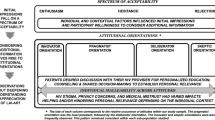Abstract
BACKGROUND: Hepatitis C virus (HCV) infection is both prevalent and undertreated.
OBJECTIVE: To identify barriers to HCV treatment in primary care practice.
DESIGN: Cross-sectional study.
SETTING AND PARTICIPANTS: A cohort of 208 HCV-infected patients under the care of a primary care physician (PCP) between December 2001 and April 2004 at a single academically affiliated community health center.
MEASUREMENTS: Data were collected from the electronic medical record (EMR), the hospital clinical data repository, and interviews with PCPs.
MAIN RESULTS: Our cohort consisted of 208 viremic patients with HCV infection. The mean age was 47.6 (±9.7) years, 56% were male, and 79% were white. Fifty-seven patients (27.4% of the cohort) had undergone HCV treatment. Independent predictors of not being treated included: unmarried status (adjusted odds ratio [aOR] for treatment 0.36, P=.02), female gender (aOR 0.31, P=.01), current alcohol abuse (aOR 0.08, P=.0008), and a higher ratio of no-shows to total visits (aOR 0.005 per change of 1.0 in the ratio of no-shows to total visits, P=.002). The major PCP-identified reasons not to treat included: substance abuse (22.5%), patient preference (16%), psychiatric comorbidity (15%), and a delay in specialist input (12%). For 13% of the untreated patients, no reason was identified.
CONCLUSIONS: HCV treatment was infrequent in our cohort of outpatients. Barriers to treatment included patient factors (patient preference, alcohol use, missed appointments), provider factors (reluctance to treat past substance abusers), and system factors (referral-associated delays). Multimodal interventions may be required to increase HCV treatment rates.
Similar content being viewed by others
References
Alter M, et al. The prevalence of hepatitis C virus infection in the United States, 1988 through 1994. N Engl J Med. 1999;341:556–62.
Flamm S. Chronic hepatitis c virus infection. JAMA. 2003;289:2413.
Fried MW, et al. Peginterferon alfa-2a plus ribavirin for chronic hepatitis C virus infection. N Engl J Med. 2002;347:975–82.
Lauer G, Walker B. Medical progress: hepatitis c virus infection. N Engl J Med. 2001;345:41.
Manns MP, et al. Peginterferon-alpha2b plus ribavirin compared with interferon-alpha2b plus ribavirin for initial treatment of chronic hepatitis C: a randomised trial. Lancet. 2001;348:958–65.
Cawthorne CH, et al. Limited success of HCV antiviral therapy in United States veterans. Am J Gastroenterol. 2002;97:149–55.
Falck-Ytter Y, et al. Surprisingly small effect of antiviral treatment in patients with hepatitis C. Ann Intern Med. 2002;136:288–92.
Yawn BP, et al. Identification and management of hepatitis C patients in primary care clinics. J Fam Pract. 2002;51:135–40.
Allen SA, et al. Treatment of chronic hepatitis C in a state correctional facility. Ann Intern Med. 2003;138:187–90.
Backmund M, et al. Treatment of hepatitis C infection in injection drug users. Hepatology. 2001;34:188–93.
Sylvestre D. Treating hepatitis C in methadone maintenance patients: an interim analysis. Drug Alcohol Dependence. 2002;67:117–23.
Thiel DHV, et al. Interferon-alpha can be used successfully in patients with hepatitis C virus-positive chronic hepatitis who have a psychiatric illness. Eur J Gastroenterol Hepatol. 1995;7:165–8.
Anonymous. Management of hepatitis c: 2002. NIH Consens State Sci Statements. 2002;19:1–46.
Librero J, Peiro S, Ordinana R. Chronic comorbidity and outcomes of hospital care: length of stay, mortality, and readmission at 30 and 365 days. J Clin Epidemiol. 1999;52:171–9.
Chou R, Clark EC, Helfand M. Screening for hepatitis C virus infection: a review of the evidence for the US preventive services task force. Ann Intern Med. 2004;140:465–79.
USPSTF. Screening for hepatitis C virus infection in adults: recommendation statement. Ann Intern Med. 2004;140:462–4.
Davis GL, Rodrigue JR. Treatment of chronic hepatitis C in active drug users. N Engl J Med. 2001;345:215–7.
Schiff E. The alcoholic patient with hepatitis C virus infection. Am J Med. 1999;107:95S-9S.
Stein MD, Maksad J, Clarke J. Hepatitis C disease among injection drug users: knowledge, perceived risk and willingness to receive treatment. Drug Alcohol Dependence. 2001;61:211–5.
Bamberger JD, et al. Helping the urban poor stay with antiretroviral HIV drug therapy. Am J Public Health. 2000;90:699–701.
Smirnoff M, et al. Directly observed therapy in an inner city hospital. Int J Tuberc Lung Dis. 1998;2:134–9.
Anonymous. Management of hepatitis C. NIH Consens Statements. 1997;15:1–41.
Edlin BR, et al. Is it justifiable to withhold treatment for hepatitis C from illicit-drug users? N Engl J Med. 2001;345:211–4.
McGinn T. How primary care enhances hepatitis C treatment (conference workshop). J Gen Intern Med. 2004;19:11.
Strader DB. Understudied populations with hepatitis C. Hepatology. 2002;36:S226–36.
Grant RW, et al. Impact of population management with direct physician feedback on care of patients with type 2 diabetes. Diabetes Care. 2003;26:2275–80.
Author information
Authors and Affiliations
Corresponding author
Additional information
The authors have no conflicts of interest to declare for this article or this research.
This work was supported by the Massachusetts General Hospital Clinical Research Program and by MGH Community Health Associates.
Rights and permissions
About this article
Cite this article
Morrill, J.A., Shrestha, M. & Grant, R.W. Barriers to the treatment of hepatitis C. J Gen Intern Med 20, 754–758 (2005). https://doi.org/10.1111/j.1525-1497.2005.0161.x
Received:
Revised:
Accepted:
Issue Date:
DOI: https://doi.org/10.1111/j.1525-1497.2005.0161.x




